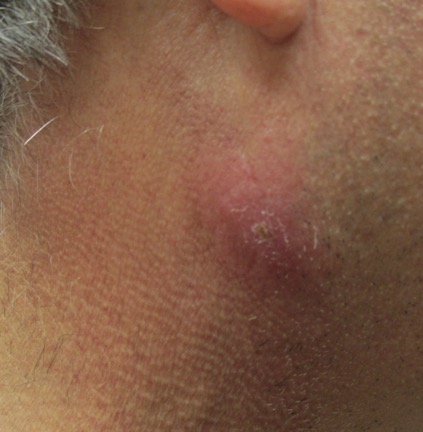CORRECT DIAGNOSIS:
Epidermolysis Bullosa Acquisita
DISCUSSION:
Epidermolysis Bullosa Acquisita (EBA) is a rare, acquired, chronic, autoimmune blistering disease. EBA is clinically characterized by blisters, scars, and milia primarily at trauma prone areas. The most common areas affected include extensor surfaces of elbows, knees, ankles, and buttocks. This disease typically presents in the third to fifth decades. EBA has been associated with numerous autoimmune diseases including SLE, RA, IBDs, DM, MEN, cryoglobulinemia, and thyroiditis. A few case reports of EBA have been reported in patients with multiple myeloma, amyloidosis, lymphoma, and CLL. The exact pathogenesis of this disorder is not well understood. EBA patients have IgG antibodies against the basement membrane. The most convincing evidence demonstrates that the autoantibodies react with type VII collagen which is the major component of anchoring fibrils. Clinical and histopathologic correlation is required for the proper diagnosis of EBA. H & E is nonspecific for EBA. Direct IF demonstrates a linear deposition of IgG along the epidermal basement membrane zone. Salt-split skin will show immune deposits along the dermal side. This disease is rarely life-threatening but usually chronic in nature and frequently recalcitrant to treatment.
TREATMENT:
Our patient was treated with a higher dose of prednisone and started on mycophenolate mofetil with an improvement of her symptoms. The eventual goal for our patient was to taper her off the prednisone and ameliorate symptoms using steroid-sparing medications.
REFERENCES:
Engineer, L., & Ahmed, A. R. (2001). Emerging treatment for epidermolysis bullosa acquisita. Journal of the American Academy of Dermatology, 44(5), 818-828. PMID: 11320126
Busch, J. O., & Sticherling, M. (2007). Epidermolysis bullosa acquisita and neuroendocrine pancreatic cancer – Coincidence or pathogenic relationship? Journal der Deutschen Dermatologischen Gesellschaft, 5(10), 916-918. PMID: 17919505
Remington, J., Chen, M., Burnett, J., & Woodley, D. T. (2008). Autoimmunity to type VII collagen: Epidermolysis bullosa acquisita. Current Directions in Autoimmunity, 10, 195-205. PMID: 18560002
Bakar, O., Demirçay, Z., & Ergun, T. (2004). Epidermolysis bullosa acquisita associated with vitiligo, Graves’ disease, and nephrotic syndrome. International Journal of Dermatology, 43(5), 378-380. PMID: 15132992
Rogers, S., Larkin, C., McDonald, G. S., Mullaney, J., & Collins, E. P. (1983). Epidermolysis bullosa acquisita with pulmonary tuberculosis: A case report. Clinical and Experimental Dermatology, 8(3), 311-318. PMID: 6342640




